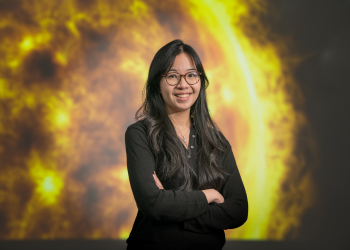A mystery which has baffled astronomers and physicists for decades is closer to being solved thanks to the work of a Northumbria University student alongside researchers in the United States during a five-week placement supported by the Turing Scheme.
The Solar Corona is the outermost part of the Sun’s atmosphere but reaches temperatures millions of degrees hotter than the surface itself. It is shaped and powered by the Sun’s magnetic field, but the exact process through which the magnetic field transfers its energy to the coronal gas has remained elusive over the last 80 years.
One theory, known as the Parker nanoflare theory, suggests the heat generated when magnetic field lines within the corona break and reconnect results in a sudden burst of energy or ‘nanoflare’.
In 2021, a team of Northumbria University researchers, led by Dr Patrick Antolin, found evidence that this reconnection produces a very rapid, sideways separation of reconnecting magnetic field lines along with a nanoflare, creating ‘nanojets’.
This phenomenon now constitutes the tell-tale sign of the nanoflare theory and could account for the solar corona’s high temperature if prevalent in the corona.
However, nanojets are difficult to detect and predict and their small sizes and short timescales make it challenging for instruments to detect them.
Developing machine learning algorithms to detect nanojets
In a bid to gather more evidence, PhD Physics student Ramada Sukarmadji has been working with scientists from the Lockheed Martin Solar and Astrophysics Laboratory (LMSAL) in the United States to develop machine learning algorithms which will automatically detect and record nanojets.
Ramada is a member of Northumbria’s world-leading Solar and Space Physics research group, which collaborates extensively with UK Research and Innovation, the UK Space Agency, the European Space Agency, the UK Met Office, and more than 40 industrial partners – including Lockheed Martin.
She recently spent five weeks working alongside LMSAL scientists in Palo Alto, California, exploring machine learning methods and numerical simulation results which could help to identify characteristics unique to the nanojets and build an automated detection algorithm for nanojets.
“We know nanojets exist and that reconnection-based heating may play a significant part in explaining why the solar corona reaches such high temperatures,” said Ramada.
“However, at the moment we can only identify nanojet occurrences by eye – what we need is a way of detecting them automatically. They are very small and difficult to identify in the corona. It is very likely that there are probably more than we think, however, to really understand them further we need to be able to detect them as they occur.
“By analysing data from previous occurrences of nanojets we can essentially ‘teach’ a computer to identify nanojets in other observations through machine learning. This will allow us to capture future events and really develop our understanding of this phenomena and how it contributes to the heating of the Corona.”
Although funding for her trip to work with scientists at LMSAL came from various sources including the European Space Agency and Northumbria University, Ramada believes gaining the support of the Turing Scheme was instrumental in allowing her to take up the opportunity.
Turing Scheme funding helps early career researchers
“The Turing Scheme didn’t cover all costs because California was unbelievably expensive,” she said. “However, I must say that the Turing Scheme unlocked all the other funding that I received. I don’t think I would have received the other funding had this not already been approved for Turing Scheme support, so without that the trip couldn’t have gone ahead.
“The Turing Scheme fund is very useful for researchers, and especially early career researchers like myself who haven’t had much opportunity to collaborate with international counterparts. This trip got me into the scientific community and may lead to other projects for me to pursue after I finish my PhD.”
Alejandra Vicencio, Head of International Mobility at Northumbria University, said: “The Turing Scheme has given us the opportunity to support more students to study and work abroad than we were able to in the past.
“We only started supporting short-term summer programmes with the Turing Scheme in 2021. Before then we didn’t have any funding associated to short programmes, but this meant we were able to grow our summer programmes, including work placements, research and volunteering.
“This experience will have a very big impact on Ramada’s development whilst at Northumbria and the connections and the networks that she can create and the type of research and the quality of the research she can undertake in the long term also.
“At the same time, it’s beneficial for our faculties because they strengthen links with partners and develop more research projects – and that’s part of a larger strategy and research agenda that is very important at Northumbria.
“That’s why we quickly decided that the Turing Scheme funding would be a good opportunity to initiate these kinds of opportunities for PhD and research students.”
Find out more about higher education funding opportunities with the Turing Scheme






